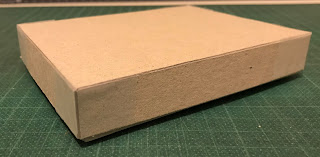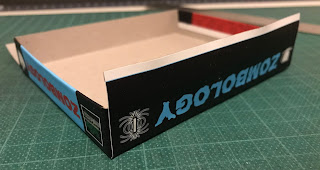If you found this interesting and are planning on attending the UK Games Expo at the beginnging of June in Birmingham you can see me hand-craft a copy of Zombology from scratch in front of a live audience! My Made by Hand seminar is 1-2pm on Sunday 3rd June in the Piazza Small.
For this tutorial you'll need a good ruler with a steel cutting edge (ideally that lies flat with the cutting surface) and a clear scale for measuring, a self-healing cutting mat and a sharp knife (I use an Xacto-style knife with snap off blades).
So, let's get started. The first thing you'll need to do is choose a box size. For this I strongly recommend choosing a game you own and making your box that size. There's three good reasons for this:
My personal philosophy is that the game box should be the smallest one that the components can comfortably fit in, but if you're hoping to go into retail your box needs to reflect your MSRP. Being the only £25 game on the small games shelf really hurt sales of Sumeria. Once you know your manufacturing cost, times that by five and go into a game store - how big are the boxes for games that cost that much?
Once you've picked a box size, measure the width (W), height (H) and depth (D - the distance between the lid opening and the top of the lid) of the box lid. The dimensions of your box blank (BW and BH) are W+2*D by H+2*D. You need two rectangles of greyboard (chipboard I think in the US and Canada) that size. I usually use 750micron (0.75 millimetres thick) greyboard for a small box or light game and 1250micron (1.25 millimetres thick) for heavy or larger games.
On that greyboard measure out two rectangles that are BW by BH. Then draw lines that are D in from every edge on one of them (this is your box lid). For the tray the lines need to be further in, for a 750micron thick box you can draw them D + 1mm in, for 1.25micron greyboard you'll need D + 2mm. Making the box blanks the same total size means that the tray is smaller, but taller than the lid - this means you have a small amount of tray showing when the lid is on, so it's easier to open the box.
The next step is to cut the small squares out from each corner of the tray and lid blanks, and to score (gently scratch with a knife - not all the way through) the remaining bits of the lines you drew.
Now turn the blanks over so the drawn and scored lines are underneath and fold the sides of the tray and lid up along the scored lines.
The final step of making the blanks is to tape the box corners. I use Scotch Magic Tape for this as it has a nice matt surface that the label sticks to nicely.
For a prototype I'll often stop there:
But for a hand-crafted game you want this to look like a real game that's been professionally manufactured. So you need labels. In the old days I used to get these printed onto paper (and then professionally laminated for durability) and then glue them on by coating them in watered down PVA glue. This is an awful idea - don't do that! For a smaller game where high fidelity isn't critical you can print onto label paper (I think you can get it in up to A4/Letter size), but I've started using Vinyl labels (also professionally laminated) for Zombology which are awesome (if expensive). Your box art will need to be W+2*D+30mm by H+2*H+30mm so that there's 15mm of label on each side to wrap over the box into the inside. Do the box label art (and getting it all the right way up!) is enough content for another post, needless to say you'll have to get this right!
My next step is to cut out the labels. You want the long edges to go from the corners of the box top/bottom straight out to the edge of the label (you can make them 2 or 3mm narrower at the label edge if you want - this makes the wrap slightly smoother on the inside, but it slows down cutting a bit as you can't do both cuts at the same time without moving the ruler). The shorter edges need to go from the corners of the box tray/lid 45° to the depth of the box, before going straight out to the label edge - see below:
Once you've cut out the labels, take the box lid label and the box lid blank (be careful at this point - the box blank lid and tray look almost identical!). Remove the label backing and place it face down. Place the box blank on top, being very careful to line up all four corners of the box blank with the corners cut into the label. Press down firmly across the whole blank surface to get a good adhesion to the label.
The next step is to do the shorter sides. Roll the blank onto one short side, pressing firmly along the blank to make sure it adheres well to the label. Now cut from just inside the corner of the box to the label edge (so the cut goes slightly towards the middle of label edge), and then again towards the corner of the label where the 45° cut turns towards the label edge. You want to err towards the 45° cut at this point, you don't want any label ending above the blank edge when you wrap the label over the corners.
Now starting in the middle and working out towards the corners, pinch the label over the edge of the blank. Make sure the label sticks really well both on the inside and the outside of the box edge.
You can now wrap the two diagonally cut pieces round the corners of the box - this strengthens the box corners and also ensures that none of the greyboard will be visible on the corners. Repeat the last four steps on the other short side.
Next up are the long edges. Roll the box blank onto one of the long edges and press down firmly along the edge to ensure the label sticks well across the whole edge.
Starting in the middle again and working out towards the corners, pinch the label over the edge of the blank. Make sure the label sticks really well both on the inside and the outside of the box edge. If you cut the long edge straight out to the label edge you might need to pay attention to pressing the label into the corners on the inside, which is less of a problem if you cut the label slightly in towards the middle. Repeat this process on the other long edge.
Repeat this process on the box tray and Hey Presto! you have a professional looking tray and lid box!
I hope this was helpful - let me know in the comments if you'd like any more details or another How To post on something else (e.g. box art layout).


















1 comment:
Great
Post a Comment